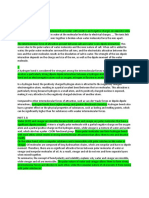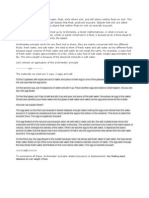General Physics2 Script
General Physics2 Script
Uploaded by
Claire DonilaCopyright:
Available Formats
General Physics2 Script
General Physics2 Script
Uploaded by
Claire DonilaOriginal Title
Copyright
Available Formats
Share this document
Did you find this document useful?
Is this content inappropriate?
Copyright:
Available Formats
General Physics2 Script
General Physics2 Script
Uploaded by
Claire DonilaCopyright:
Available Formats
GENERAL PHYSICS2 SCRIPT (MIDTERM)
What Happens When You Add a Drop of Food Coloring to Cold Water?
ANSWER: Food coloring illustrates diffusion in water. Diffusion is the mixing of molecules due
to their random motion, whether in a liquid or a gas. Because molecules in cold water have
less kinetic energy than in warm water, the diffusion process is much slower than in warm
water. But the food coloring can also show movement that isn't random, such as agitation of
the water by convection.
What Happens When You Add a Drop of Food Coloring to Hot Water ?
ANSWER: The food coloring mixes through the hot water faster than it mixes with the cold water. This
is because in hot water, the water molecules have more energy and are moving faster than the
molecules of cold water. This makes it easier for the dye to get mixed throughout the hot water.
Because diffusion happens from high concentration to low concentration, the more molecules are
moving, the more opportunities they have to mix together.
What Happens When You Add a Drop of Food Coloring to Room Temperature
Water?
ANSWER: The food coloring in the room temperature water will take longer to mix with
the water because the molecules are moving more slowly due to their decreased thermal energy. Lastly,
the food coloring in the cold water will take a long time to mix with the water because the molecules are
moving even slower due to a further decrease in thermal energy.
Eventually, the food coloring will mix throughout all of the
jars.
When observing the food coloring in the water, wewill immediately notice that
it behaves differently based on the temperature of the water.
Even though the glasses of water look the same, the difference in the water
temperature causes the molecules that make up the water to behave
differently. Molecules that make up matter move faster when they are warmer
because they have more thermal energy and slower when they are colder
because they have less thermal energy. In this experiment, the molecules in
the hot water are moving around much faster than the molecules in the cold
water.
Thermal Energy is the total energy of the particles in an object.
When placed into water, food coloring will begin to mix with the water. The
food coloring will mix the fastest in the hot water because the molecules are
moving fast due to their increased thermal energy. These fast-moving
molecules are pushing the molecules of food coloring around as they move,
causing the food coloring to spread faster.
The food coloring in the room temperature water will take longer to mix with
the water because the molecules are moving more slowly due to their
decreased thermal energy.
Lastly, the food coloring in the cold water will take a long time to mix with the
water because the molecules are moving even slower due to a further
decrease in thermal energy.
You might also like
- C 10ef 2 0 Explain StemscopediaDocument7 pagesC 10ef 2 0 Explain Stemscopediaapi-2368267470% (1)
- Phase Change Lab ReportDocument1 pagePhase Change Lab ReportSean Munroe100% (5)
- Hi-Yield Notes in AnatomyDocument31 pagesHi-Yield Notes in AnatomyJohn Christopher Luces100% (4)
- Explanation Sci GroupDocument1 pageExplanation Sci GroupElissah S PabilonaNo ratings yet
- ch1 l2 Activity Sheet AnswersDocument2 pagesch1 l2 Activity Sheet AnswersElla RogalskyNo ratings yet
- 5e Lesson Plan Water MoleculesDocument5 pages5e Lesson Plan Water Moleculesapi-309263497100% (1)
- Diffusion and Osmosis ExperimentDocument1 pageDiffusion and Osmosis ExperimentJodeth C. CorpuzNo ratings yet
- Activity 1: Guide QuestionsDocument2 pagesActivity 1: Guide QuestionsReuben John AbalayanNo ratings yet
- Why Does The Sugar Dissolve Slowly in Cold WaterDocument2 pagesWhy Does The Sugar Dissolve Slowly in Cold WaterDenn Kelly PengsonNo ratings yet
- Matter On The MoveDocument1 pageMatter On The Moveapi-112265046No ratings yet
- UntitledDocument4 pagesUntitledZenith OxgnNo ratings yet
- Mixtures Notes PDFDocument5 pagesMixtures Notes PDFKhaled ElsayedNo ratings yet
- Test Bank - Chapter 2: Multiple ChoiceDocument10 pagesTest Bank - Chapter 2: Multiple ChoiceMark ContrerasNo ratings yet
- Particulate Nature of MatterDocument5 pagesParticulate Nature of MatterLe Maurice CiminiNo ratings yet
- Gen Bio 5Document9 pagesGen Bio 5jasmin perezNo ratings yet
- Grade 9-Chem-Ch-1-Notes-1Document14 pagesGrade 9-Chem-Ch-1-Notes-1Aarushi 8741No ratings yet
- 1.2 TeacherDocument6 pages1.2 TeacherluiskNo ratings yet
- Group1 Lab2Document5 pagesGroup1 Lab2ap0ptosisNo ratings yet
- ch1 l3 Activity Sheet AnswersDocument2 pagesch1 l3 Activity Sheet Answersp10794162No ratings yet
- Solution: ExperimentationDocument39 pagesSolution: ExperimentationHazel OlayNo ratings yet
- Science 7 ReviewerDocument3 pagesScience 7 ReviewerArgie Mabag100% (3)
- The Lava LampDocument5 pagesThe Lava LampMathew DegamoNo ratings yet
- DiffusionDocument16 pagesDiffusionAbhinandan Sanduja100% (1)
- Lesson 4 CHEM HandoutsDocument4 pagesLesson 4 CHEM Handoutscarl.keiron03No ratings yet
- MeasuringDocument13 pagesMeasuringsrini9047No ratings yet
- ch1 l2 Lesson PlanDocument6 pagesch1 l2 Lesson Planp10794162No ratings yet
- Chem InvestigatoryDocument15 pagesChem InvestigatoryShivam PandeyNo ratings yet
- To Study The Diffusion of Solids in LiquidsDocument18 pagesTo Study The Diffusion of Solids in Liquidsdeepak876No ratings yet
- Fdocuments - in - To Study The Diffusion of Solids in LiquidsDocument17 pagesFdocuments - in - To Study The Diffusion of Solids in Liquidsabhishektatu2007No ratings yet
- Measuring Solubility of Saturated SolutionDocument10 pagesMeasuring Solubility of Saturated SolutionSRI KATHIRNo ratings yet
- Chemistry Notes (Chapter 1)Document14 pagesChemistry Notes (Chapter 1)NiranjanNo ratings yet
- Science Report On DiffusionDocument2 pagesScience Report On DiffusionChristian KapsalesNo ratings yet
- Satured SolutionDocument10 pagesSatured SolutionSRI KATHIRNo ratings yet
- REVISION FINAL - MATTER IN OUR SURROUNDINGS - DoneDocument14 pagesREVISION FINAL - MATTER IN OUR SURROUNDINGS - DoneRaghvendra ShrivastavaNo ratings yet
- Transport 3Document5 pagesTransport 3jeremaluwa1No ratings yet
- Activity 1. Boiling Point Elevation at Home ProcedureDocument2 pagesActivity 1. Boiling Point Elevation at Home ProcedureYna Louise MagluyanNo ratings yet
- Liquid Stick-Liquid Light: ExperimentDocument1 pageLiquid Stick-Liquid Light: Experiment刘会禧No ratings yet
- Untitled DocumentDocument5 pagesUntitled Documentcrilly961No ratings yet
- Project 12 - RealDocument26 pagesProject 12 - RealyogeswaranveluNo ratings yet
- Chapter-1 - MATTER IN OUR SURROUNDINGSDocument20 pagesChapter-1 - MATTER IN OUR SURROUNDINGSSATYAM RATHOURNo ratings yet
- Effects of Change of TemperatureDocument2 pagesEffects of Change of TemperatureRayyan AhsanNo ratings yet
- 2 2water 2Document30 pages2 2water 2Zeineb AbbasNo ratings yet
- Project On TitleDocument17 pagesProject On Titleharsh vardhanNo ratings yet
- PHYSICSDocument8 pagesPHYSICSAldrin E. Naranjo HernándezNo ratings yet
- Life DefendwaterDocument2 pagesLife DefendwatergaweshajeewaniNo ratings yet
- Bio Lab Report Water PropertiesDocument2 pagesBio Lab Report Water Propertiesapi-439891660No ratings yet
- MatterDocument4 pagesMatterJacinta MartinNo ratings yet
- ch1 l2 Activity SheetDocument3 pagesch1 l2 Activity Sheetp10794162No ratings yet
- Disappearing Sugar Cubes PDFDocument12 pagesDisappearing Sugar Cubes PDFboyboNo ratings yet
- Properties of WaterDocument55 pagesProperties of Waterr39174746No ratings yet
- General Chemistry 2Document2 pagesGeneral Chemistry 2jcjimz259No ratings yet
- Chem ProjectDocument26 pagesChem ProjectyogeswaranveluNo ratings yet
- Properties of Water Station LabDocument6 pagesProperties of Water Station Lablaquisha.smithNo ratings yet
- Some ObjectsDocument1 pageSome ObjectsErline Bismonte AndayaNo ratings yet
- Module 8Document21 pagesModule 8Mila Grace TungalaNo ratings yet
- Csec Chemistry Chapter 1 - States of MatterDocument8 pagesCsec Chemistry Chapter 1 - States of Matterchelsea AlexandriaNo ratings yet
- Principles of ChemistryDocument14 pagesPrinciples of ChemistrydinuNo ratings yet
- Reaction PaperDocument1 pageReaction PaperJames Patrick TorresNo ratings yet
- Transport 2Document7 pagesTransport 2jeremaluwa1No ratings yet
- Oil and Water Won't Mix and Other Mixture Separation Techniques - Chemistry Book for Kids 8-10 | Children's Chemistry BooksFrom EverandOil and Water Won't Mix and Other Mixture Separation Techniques - Chemistry Book for Kids 8-10 | Children's Chemistry BooksNo ratings yet
- Physical Fitness Test Score CardDocument2 pagesPhysical Fitness Test Score CardDafchen Nio Mahasol100% (1)
- Paleo Canteen Low Carb On A Budget PDFDocument37 pagesPaleo Canteen Low Carb On A Budget PDFHaroldo FalcãoNo ratings yet
- 10 Doh Approved Herbal PlantsDocument7 pages10 Doh Approved Herbal PlantsLaura VillegasNo ratings yet
- Organic Chemistry Laboratory: Report 6: Reflux ReactionDocument7 pagesOrganic Chemistry Laboratory: Report 6: Reflux ReactionPhú NguyễnNo ratings yet
- 4 - Question Paper Division Annexure CDocument3 pages4 - Question Paper Division Annexure Cravipatidar0057No ratings yet
- Bone AssignmentDocument21 pagesBone AssignmentTayaba Naim KhanNo ratings yet
- Municipal Health Office Municipality of Claveria, CagayanDocument2 pagesMunicipal Health Office Municipality of Claveria, CagayanSophia Kaye AguinaldoNo ratings yet
- Acids, Derivatives and NitrilesDocument23 pagesAcids, Derivatives and NitrilesLuqman HakimNo ratings yet
- Adm q2 Grade9 Cookery v3Document35 pagesAdm q2 Grade9 Cookery v3Sammie WuttNo ratings yet
- CH 17 Thermochemistry Practice Test: Name: Julia Anne Rosales Class: - Date: - ID: ADocument8 pagesCH 17 Thermochemistry Practice Test: Name: Julia Anne Rosales Class: - Date: - ID: AJulia Anne RosalesNo ratings yet
- Desmodur RE: CharacterizationDocument3 pagesDesmodur RE: CharacterizationMehulNo ratings yet
- Role of New Age Media in Pakistan (2019-2021) .Document30 pagesRole of New Age Media in Pakistan (2019-2021) .Nazra NoorNo ratings yet
- Taenia SoliumDocument43 pagesTaenia SoliumKhushbu Yadav100% (1)
- Industrial Gas Generator Illustrated Parts CatalogueDocument5 pagesIndustrial Gas Generator Illustrated Parts CataloguejuanaNo ratings yet
- SK Wallpaper Floral PVC Self Adhesive Waterproof Wallpaper Fabric Safety Home Decor Wall Covering For Living Room Bedroom Backgr PDFDocument1 pageSK Wallpaper Floral PVC Self Adhesive Waterproof Wallpaper Fabric Safety Home Decor Wall Covering For Living Room Bedroom Backgr PDFReighnn CarnacetoNo ratings yet
- Tamil Nadu Manual Worker (Regulation of Employment and Conditions of Work) Act, 1982.Document29 pagesTamil Nadu Manual Worker (Regulation of Employment and Conditions of Work) Act, 1982.Latest Laws TeamNo ratings yet
- Reverse Osmosis-Deionization Systems To PurifyDocument11 pagesReverse Osmosis-Deionization Systems To PurifyCarlos AugustoNo ratings yet
- Project ArwaDocument29 pagesProject ArwaMohannad HemedaNo ratings yet
- CW602N Is No Longer Listed PDFDocument8 pagesCW602N Is No Longer Listed PDFMahmoud AbouelhassanNo ratings yet
- Final Exam Consmat!!Document2 pagesFinal Exam Consmat!!JV RatmanNo ratings yet
- Air Inlet and Exhaust SystemDocument10 pagesAir Inlet and Exhaust SystemRajaa XFNo ratings yet
- SAP PM Standard ReportsDocument19 pagesSAP PM Standard ReportsGowtham Krishna Maganti100% (2)
- Prevalence of Anaemia Among Adolescent Girls: A Cross Sectional Exploratory StudyDocument3 pagesPrevalence of Anaemia Among Adolescent Girls: A Cross Sectional Exploratory StudyJamilaNo ratings yet
- ASTMD2867-17 (2017) MoistureDocument3 pagesASTMD2867-17 (2017) MoistureAditya PutriNo ratings yet
- Comprehensive Development Plan 2018 2022Document223 pagesComprehensive Development Plan 2018 2022Rhobie Shayne BenogsodanNo ratings yet
- Ac 32Document16 pagesAc 32حِمْيَرْ مٌقْبِلْ الكَوْلِيNo ratings yet
- Design of Mobile Applications For People With Intellectual DisabilitiesDocument14 pagesDesign of Mobile Applications For People With Intellectual DisabilitiesFaizaNo ratings yet
- Ship Stability B QuestionDocument46 pagesShip Stability B QuestionAljohn Nanez67% (3)
- The External EnvironmentDocument2 pagesThe External EnvironmentNSRanganathNo ratings yet

























































































